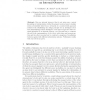Free Online Productivity Tools
i2Speak
i2Symbol
i2OCR
iTex2Img
iWeb2Print
iWeb2Shot
i2Type
iPdf2Split
iPdf2Merge
i2Bopomofo
i2Arabic
i2Style
i2Image
i2PDF
iLatex2Rtf
Sci2ools
DAGSTUHL
2003
2003
Towards Imitation Learning from a Viewpoint of an Internal Observer
How an internal observer, that is not given any a priori knowledge or interpretation of what its sensors receives, learn to imitate seems a formidable issue from a viewpoint of a constructivist approach towards both establishing the design principle for an intelligent robot and understanding human intelligence. This paper argue two issues towards imitation by an internal observer: one concerns how to construct the self body representation of the robot with vision and proprioception and the other concerns how to construct a mapping of vocalization between agents with different articulation systems. Preliminary results with real robots are given.
| Added | 31 Oct 2010 |
| Updated | 31 Oct 2010 |
| Type | Conference |
| Year | 2003 |
| Where | DAGSTUHL |
| Authors | Yuichiro Yoshikawa, Minoru Asada, Koh Hosoda |
Comments (0)

